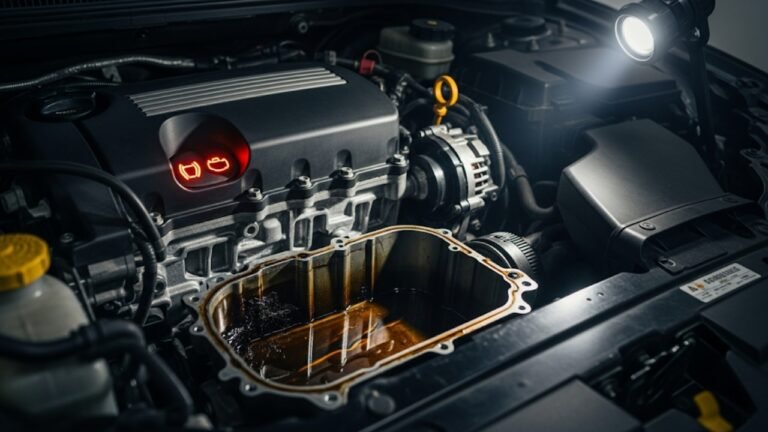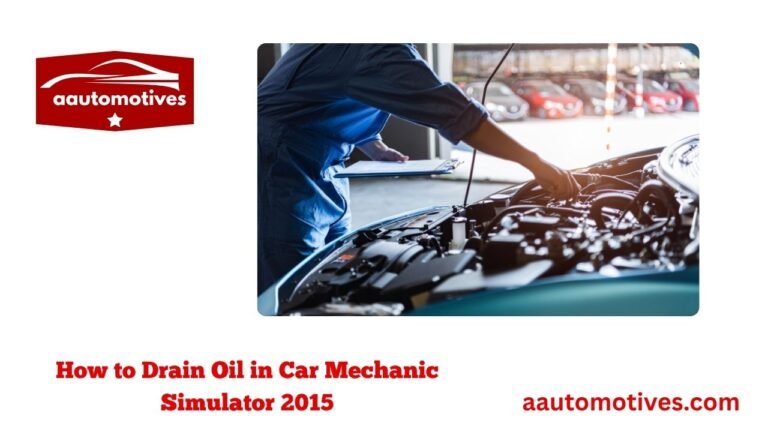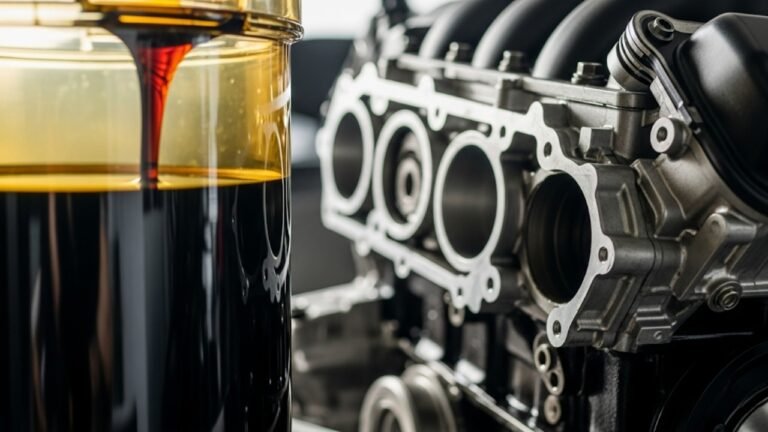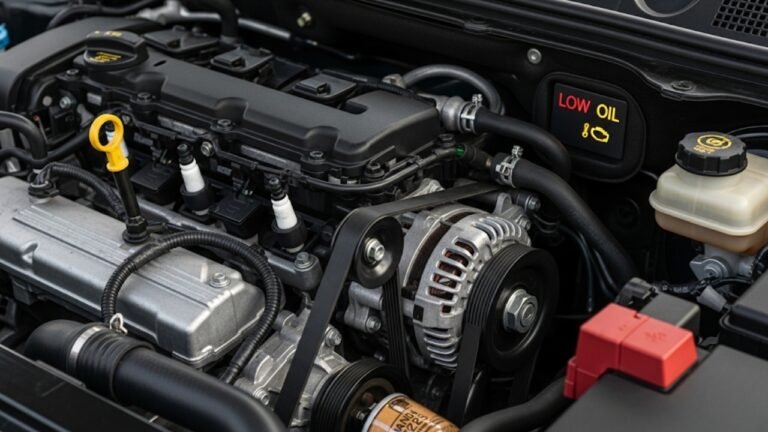Where Can Oil Leak from a Car? A Friendly Guide
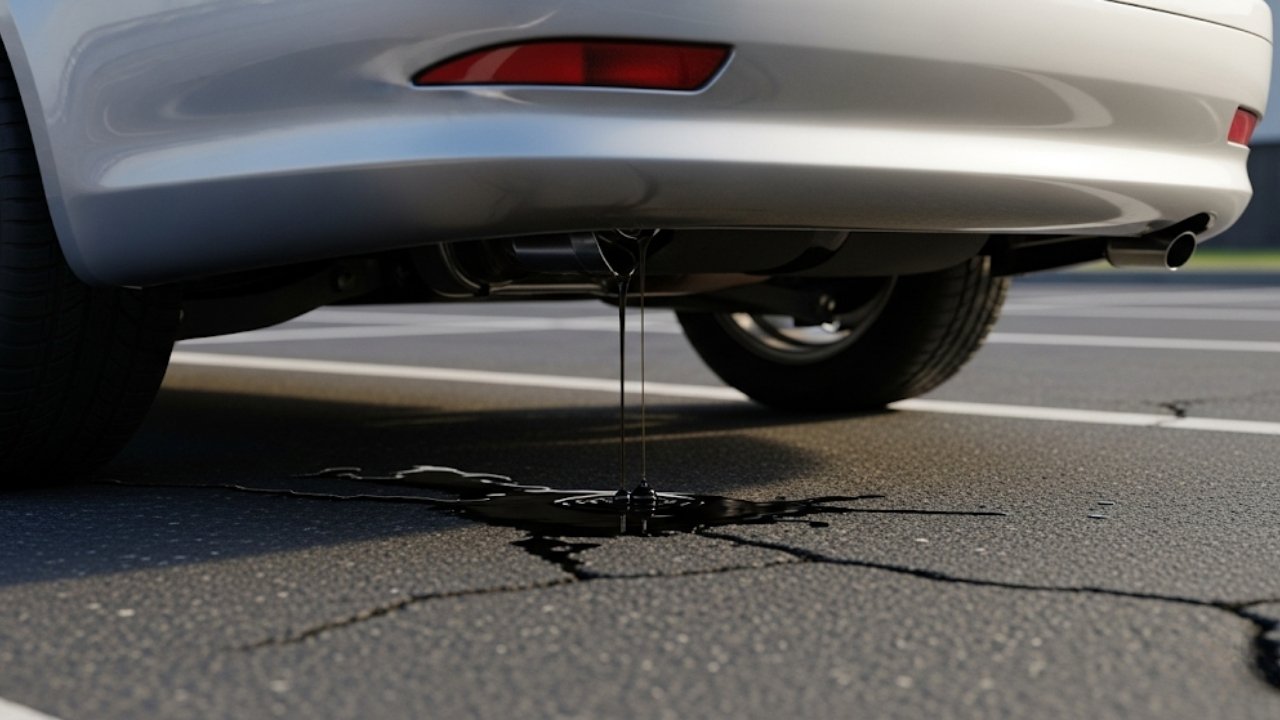
You know that feeling—you’re walking to your car on a bright morning, coffee in one hand, keys in the other… and there it is. A dark, oily puddle under the engine. Instantly, your heart sinks. You ask yourself, “Where can oil leak from a car?” It’s frustrating, isn’t it? I’ve been there more than once, and let me tell you—it’s never just a small thing. Oil leaks can quietly drain your wallet if you ignore them.
But don’t worry. This guide will walk you through every common place oil can leak from, explain how to spot the signs, and help you prevent costly damage. I’ll explain everything in a simple way, just like we’re chatting over a cup of tea. Whether you’re new to cars or have been wrenching for years, this is for you.
Let’s dig in—and save that engine!
In This Article
- 1 Why Oil Leaks Are a Big Deal
- 2 Common Oil Leak Sources in a Car (Table Overview)
- 3 1. Oil Pan Gasket – The Usual Suspect Below
- 4 2. Valve Cover Gasket – Top-Side Trouble
- 5 3. Oil Filter – A Simple Part with a Big Role
- 6 4. Oil Drain Plug – The Common DIY Pitfall
- 7 5. Front or Rear Main Seals – The Sneaky Leakers
- 8 6. Timing Cover Gasket – The Messy Middle
- 9 7. PCV Valve and Grommet – The Pressure Cooker Problem
- 10 8. Camshaft and Crankshaft Seals – Slow and Steady Leaks
- 11 Tips to Prevent Oil Leaks Before They Start
- 12 FAQs About Oil Leaks in Cars
- 12.1 1. How can I tell if my car is leaking oil?
- 12.2 2. Is it safe to drive a car with an oil leak?
- 12.3 3. How much does it cost to fix an oil leak?
- 12.4 4. Why is my car leaking oil after an oil change?
- 12.5 5. What kind of oil leak is most dangerous?
- 12.6 6. Do older cars leak oil more often?
- 12.7 7. Can oil leaks cause a fire?
- 12.8 8. Is oil leaking the same as burning oil?
- 13 Wrapping It All Up: Fix the Leak, Save the Ride
Why Oil Leaks Are a Big Deal

Your engine oil is its lifeblood. It lubricates moving parts, reduces heat, prevents corrosion, and keeps everything running smoothly. When that oil leaks out, the engine is basically running dry. That’s like going for a long run without drinking water—it won’t end well.
I once ignored a small leak, thinking it was no big deal. Two months later, my engine seized while I was stuck in traffic. Trust me—you don’t want that kind of stress (or the repair bill).
Here’s what oil leaks can lead to:
-
Engine overheating
-
Premature wear and tear
-
Damaged gaskets and seals
-
Pollution (yeah, it’s not just a driveway problem)
Now, let’s see where the oil might be escaping from.
Common Oil Leak Sources in a Car (Table Overview)
Here’s a quick breakdown of where oil can leak from a car, followed by detailed explanations:
| Part | Location | Symptoms | Risk Level |
|---|---|---|---|
| Oil Pan Gasket | Bottom of engine | Drips under car | Medium |
| Valve Cover Gasket | Top of engine | Burning smell, oily engine top | High |
| Oil Filter | Near engine block | Fresh oil around filter | Medium |
| Oil Drain Plug | Bottom of oil pan | Oil puddle under car | Medium |
| Front and Rear Main Seals | Front/back of engine | Heavy leaks, clutch issues | High |
| Timing Cover Gasket | Front of engine | Dirty belt area | High |
| PCV Valve/Grommet | Top of engine | Pressure buildup, messy leak | Medium |
| Camshaft/Crankshaft Seals | Front of engine | Slow leaks, grime buildup | Medium |
Now let’s break each one down.
1. Oil Pan Gasket – The Usual Suspect Below
The oil pan gasket sits between the oil pan and the bottom of the engine block. This area takes a beating. It’s exposed to road debris, high heat, and vibration. Over time, the gasket hardens and cracks, letting oil seep through.
How can you tell? Look for:
-
Fresh or sticky oil under the car
-
Drips forming after parking overnight
-
A dirty or oily lower engine area
I once had a beat-up old Honda where the oil pan gasket leaked so slowly, I didn’t notice for weeks. But after enough buildup, the car began to smoke every time I stopped at a red light. Embarrassing, right?
What to Do:
-
Check under the car for signs of oil
-
Replace the gasket if it’s worn
-
Use a torque wrench to avoid over-tightening (a common mistake)
2. Valve Cover Gasket – Top-Side Trouble
Here’s another big one. The valve cover gasket seals the very top of the engine. It prevents oil from leaking out where the valves and rocker arms are located.
Over time, especially in older cars, this rubber seal gets brittle. It cracks. It lets oil spill down the engine block. And that causes a nasty burning smell as it hits the hot exhaust.
I remember fixing a Toyota Camry that had a leaking valve cover gasket. Every time I turned the heat on, the cabin smelled like a barbecue. That’s when I knew something was wrong.
Signs to watch:
-
Oily spots on the top of the engine
-
Burning oil smell while driving
-
Oil in spark plug wells
This isn’t something to delay. A leaky valve cover can ruin spark plugs and damage sensors.
3. Oil Filter – A Simple Part with a Big Role
You’d be surprised how often the oil filter is the culprit. Every time you change your oil, the filter gets swapped out. But if it’s not installed right, or the seal isn’t seated properly, it leaks.
Some people even leave the old gasket on by mistake. That leads to double-gasketing, which causes oil to spray out under pressure.
You’ll notice:
-
Fresh, clean oil near the oil filter area
-
Dripping after an oil change
-
Sudden oil pressure drops on the dash
One time, my buddy did his own oil change and forgot to tighten the filter. It dumped half a quart of oil before he even left his driveway.
Quick Tip:
Always hand-tighten the oil filter snugly, but not too tight. Double-check for old gasket rings stuck to the block.
4. Oil Drain Plug – The Common DIY Pitfall
The oil drain plug is another common source of leaks. It’s the bolt at the bottom of your oil pan that you remove during an oil change.
Many times, leaks here happen due to:
-
A loose or stripped plug
-
A missing or damaged crush washer
-
Cross-threaded installation
You might think it’s secure, but if you overtighten it, the threads can strip. That’s when the real problems start. You’ll see a puddle on the ground, especially after a fresh oil change.
I had a friend who overtightened his drain plug so badly, it cracked the pan. He had to replace the whole oil pan.
Signs include:
-
Oil directly under the pan
-
Slow drips that increase after driving
-
Oil loss despite a recent top-up
5. Front or Rear Main Seals – The Sneaky Leakers
These seals are located at either end of the crankshaft—front main seal behind the timing cover and rear main seal near the transmission.
When these fail, you’re in for a challenge. The leak might not be visible right away. It slowly spreads over time, and often by the time you notice, the clutch or flywheel is oily too (in manual cars).
Clues include:
-
Oil around the bell housing or transmission
-
Oil smell inside the cabin
-
Sudden drops in oil pressure without external puddles
I’ve seen many cars with these types of leaks come into the shop. Fixing them involves taking apart a lot of engine or transmission components. It’s labor-heavy, so spotting the issue early saves time and money.
6. Timing Cover Gasket – The Messy Middle
Your engine’s timing cover protects the timing chain or belt. It’s sealed with a gasket that can fail due to heat and age. When that happens, oil leaks down the front of the engine.
What makes this tricky is that the area often gets coated in road grime, making it hard to spot fresh leaks. But you’ll know something’s off when:
-
You see oil around the serpentine belt or pulleys
-
The timing area looks darker or greasy
-
The belt starts slipping or squeaking
I worked on a Nissan once where the timing cover leak went unnoticed for months. By the time we caught it, the belt had worn unevenly and needed replacement too.
7. PCV Valve and Grommet – The Pressure Cooker Problem
The PCV (Positive Crankcase Ventilation) valve might sound like a minor component, but it plays a big role in oil control. This valve regulates pressure inside your engine. When it fails, excess pressure builds up and forces oil out through seals and gaskets.
It’s like shaking a soda bottle—eventually, it bursts.
If the PCV grommet (the rubber seal that holds the valve) wears out, oil seeps around it. Over time, you’ll notice oily spots near the top of the engine.
Watch for:
-
Sticky oil residue near the valve cover
-
Blue smoke from the tailpipe
-
High engine pressure codes (if you scan for them)
In my old Mazda, I ignored the clogged PCV valve. The buildup blew the valve cover gasket. Replacing both parts cost way more than just checking that tiny valve during maintenance.
Quick Tip:
Check your PCV valve every 20,000–30,000 km. It’s cheap and can save you from expensive leaks.
8. Camshaft and Crankshaft Seals – Slow and Steady Leaks
Both camshaft seals and crankshaft seals are found at the front of your engine. These circular seals keep oil inside the engine where the camshaft and crankshaft poke through.
The problem? They often leak slowly and silently. You might not notice until the entire front of your engine looks like it’s been dipped in grease.
Signs include:
-
Oil leaks near the timing cover area
-
Dirty or stained engine front
-
Low oil levels over time, with no visible puddles
When I worked in a repair garage, we called these “ghost leaks.” One time, a customer brought in a Subaru that was losing oil but had no visible drips. After a closer look, we found the cam seal weeping oil behind the timing belt.
The fix was easy but finding it took experience. If you’re seeing regular oil drops without a clear source, these seals are a good place to start looking.
Tips to Prevent Oil Leaks Before They Start
Now that we’ve covered where can oil leak from a car, let’s talk about how to prevent it. You don’t have to wait for a puddle to take action. Here are some simple steps you can take to protect your engine and your wallet:
✅ Use High-Quality Engine Oil
Cheap oil breaks down faster and leaves behind residue that clogs passages. Always use oil that meets your vehicle’s spec.
✅ Stick to Regular Oil Changes
Old oil turns acidic and breaks down gaskets over time. Stick to a routine—every 5,000 to 8,000 km for most cars.
✅ Check Seals and Gaskets Annually
Ask your mechanic to inspect key gaskets during routine service. A small repair today can prevent a big problem later.
✅ Don’t Overfill Oil
Too much oil causes excess pressure. That pressure finds a way out—usually through a gasket or seal.
✅ Replace PCV Valve as Needed
This simple $10 part is a big player in engine pressure control. Don’t skip it.
✅ Watch for Warning Signs
Pay attention to oil smells, smoke, or warning lights. A tiny leak caught early is easy to manage.
✅ Park on a Clean Surface
Sometimes the only way to catch a leak early is to look for it. A clean driveway or cardboard under your car helps reveal fresh spots fast.
FAQs About Oil Leaks in Cars
1. How can I tell if my car is leaking oil?
Look under your car for dark spots, check the dipstick for dropping levels, and sniff for burning oil smells. Smoke from the hood or blue exhaust are also warning signs.
2. Is it safe to drive a car with an oil leak?
Short-term? Maybe. Long-term? Definitely not. Small leaks can turn into big problems fast, and losing too much oil can destroy your engine.
3. How much does it cost to fix an oil leak?
It depends on the source. A new drain plug gasket might cost $10. A rear main seal? That could run you $800–$1,200 due to labor.
4. Why is my car leaking oil after an oil change?
It could be a loose drain plug, double-gasketed oil filter, or overfilled oil. Check everything was done correctly before driving too far.
5. What kind of oil leak is most dangerous?
Leaks near the rear main seal or timing cover can be serious. If the oil gets on your timing belt or clutch, it may lead to major engine or transmission damage.
6. Do older cars leak oil more often?
Yes. Over time, rubber seals and gaskets naturally degrade. Regular maintenance becomes more important as your car ages.
7. Can oil leaks cause a fire?
It’s rare, but possible. Oil dripping on a hot exhaust manifold can ignite. If you smell burnt oil, get it checked fast.
8. Is oil leaking the same as burning oil?
No. A leak means oil is escaping the engine. Burning oil happens inside the combustion chamber, often due to worn piston rings or valve seals.
Wrapping It All Up: Fix the Leak, Save the Ride
So, the next time you ask yourself, “Where can oil leak from a car?” you’ll know the answer isn’t simple—but it is manageable. From oil pan gaskets to camshaft seals, the possibilities are many, but none are impossible to handle.
Oil leaks are like slow leaks in a balloon. You might not notice at first. But over time, pressure drops, and eventually, you’re left with a lifeless lump. The same goes for your car’s engine. Let the oil escape long enough, and the heart of your car gives out.
Don’t let that happen.
Check your oil regularly. Trust your nose, eyes, and instincts. And if something smells burnt or seems off—look deeper. Sometimes, the smallest signs save the biggest repairs.
I’ve had my fair share of leaks—from the subtle to the disastrous. I’ve learned to treat oil like I treat health—ignore the symptoms, and the disease spreads. Address it early, and you’re back on the road with peace of mind.
Keep your engine clean. Keep your oil inside. And most of all, keep your car alive.

